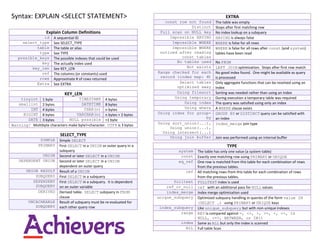Melden
Teilen
Downloaden Sie, um offline zu lesen

Empfohlen
Empfohlen
Weitere ähnliche Inhalte
Was ist angesagt?
Was ist angesagt? (6)
Hive Tutorial | Hive Architecture | Hive Tutorial For Beginners | Hive In Had...

Hive Tutorial | Hive Architecture | Hive Tutorial For Beginners | Hive In Had...
Andere mochten auch
Andere mochten auch (20)
How to Analyze and Tune MySQL Queries for Better Performance

How to Analyze and Tune MySQL Queries for Better Performance
How to analyze and tune sql queries for better performance percona15

How to analyze and tune sql queries for better performance percona15
How to Analyze and Tune MySQL Queries for Better Performance

How to Analyze and Tune MySQL Queries for Better Performance
How to analyze and tune sql queries for better performance vts2016

How to analyze and tune sql queries for better performance vts2016
How to analyze and tune sql queries for better performance webinar

How to analyze and tune sql queries for better performance webinar
What you wanted to know about MySQL, but could not find using inernal instrum...

What you wanted to know about MySQL, but could not find using inernal instrum...
How Booking.com avoids and deals with replication lag

How Booking.com avoids and deals with replication lag
Using Optimizer Hints to Improve MySQL Query Performance

Using Optimizer Hints to Improve MySQL Query Performance
Ähnlich wie My sql explain cheat sheet
Ähnlich wie My sql explain cheat sheet (20)
Mehr von Achievers Tech
Mehr von Achievers Tech (6)
Accessibility: A Journey to Accessible Rich Components

Accessibility: A Journey to Accessible Rich Components
Profiling and Tuning a Web Application - The Dirty Details

Profiling and Tuning a Web Application - The Dirty Details
My sql explain cheat sheet
- 1. Syntax: EXPLAIN <SELECT STATEMENT> Explain Column Definitions id A sequential ID select_type See SELECT_TYPE table The table or alias type See TYPE possible_keys The possible indexes that could be used key The actually index used key_len See KEY_LEN ref The columns (or constants) used rows Approximate # of rows returned Extra See EXTRA EXTRA const row not found The table was empty Distinct Stops after first matching row Full scan on NULL key No index lookup on a subquery Impossible HAVING HAVING is always false Impossible WHERE WHERE is false for all rows Impossible WHERE noticed after reading const tables WHERE is false for all rows after const (and system) tables have been read No tables used No FROM Not exists LEFT JOIN optimization. Stops after first row match Range checked for each record (index map: N) No good index found. One might be available as query is processed Select tables optimized away Only aggregate functions that can be resolved using an index Using filesort Sorting was needed rather than using an index Using temporary During execution a temporary table was required Using index The query was satisfied using only an index Using where A WHERE clause exists Using index for group- by GROUP BY or DISTINCT query can be satisfied with an index Using sort_union(...), Using union(...), Using intersect(...) index_merge join type Using join buffer Join was performed using an internal buffer KEY_LEN tinyint 1 byte TIMESTAMP 4 bytes smallint 2 bytes DATETIME 8 bytes INT 4 bytes CHAR(n) n bytes BIGINT 8 bytes VARCHAR(n) n bytes + 2 bytes DATE 3 bytes NULL possible +1 byte Warning! Multibyte characters make byte!=character. UTF8 is 3 bytes SELECT_TYPE SIMPLE Simple SELECT PRIMARY First SELECT in a UNION or outer query in a subquery UNION Second or later SELECT in a UNION DEPENDENT UNION Second or later SELECT in a UNION dependent on outer query UNION RESULT Result of a UNION SUBQUERY First SELECT in a subquery DEPENDENT SUBQUERY First SELECT in a subquery. It is dependent on an outer variable DERIVED Derived table. SELECT subquery in FROM clause UNCACHEABLE SUBQUERY Result of subquery must be re-evaluated for each other query row TYPE system The table has only one value (a system table) const Exactly one matching row using PRIMARY or UNIQUE eq_ref One row is matched from this table for each combination of rows from the previous tables. ref All matching rows from this table for each combination of rows from the previous tables. fulltext FULLTEXT index is used ref_or_null ref with an additional pass for NULL values index_merge Index merge optimization used unique_subquery Optimized subquery handling in queries of the form value IN (SELECT …) using PRIMARY or UNIQUE keys index_subquery Like unique_subquery but with non-unique indexes range KEY is compared against =, <>, >, >=, <, <=, IS NULL, <=>, BETWEEN, or IN() index Same as ALL but only the index is scanned ALL Full table Scan
